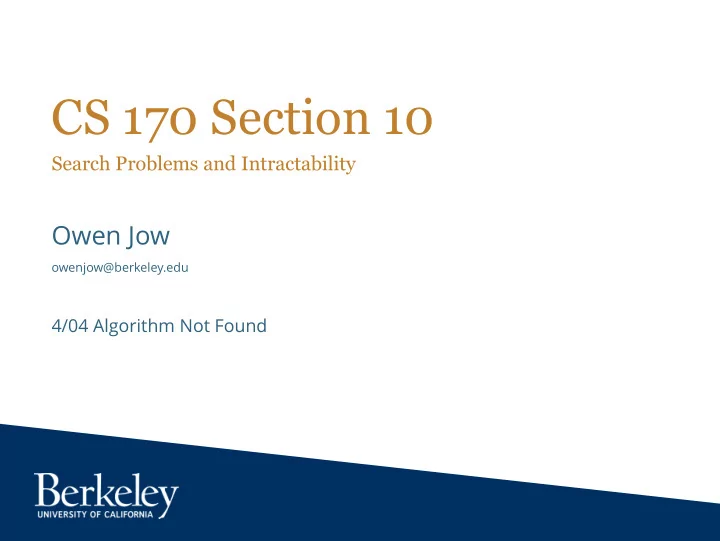

CS 170 Section 10 Search Problems and Intractability Owen Jow owenjow@berkeley.edu 4/04 Algorithm Not Found
Search Problem • Find a solution S to the problem instance I . • A solution can be verified in polynomial time by the algorithm C ( I , S ) . Examples SAT: find a satisfying truth assignment for a Boolean formula. TSP: find a tour 1 of total distance b or less. 1 a cycle that passes through every vertex exactly once
Optimization Problem • Find the best solution S to the problem instance I . • ”Best” should be quantified by some objective function. Examples MAX-SAT: find the max number of clauses that can be simultaneously true. TSP-OPT: find a tour of minimum distance.
Search vs Optimization • Search and optimization formulations are of equal difficulty. • Why? Each reduces to the other. TSP ← → TSP-OPT
P vs NP • P: all search problems that can be solved in polynomial time • NP: all search problems (i.e. “verifiable in polynomial time”) • NP-complete: the problems to which all search problems reduce • NP-hard: “at least as hard as the NP-complete problems” I know an NP-complete joke, but once you’ve heard one you’ve heard them all. jason , Stack Overflow
3SAT HORN SAT TSP MST ILP LP RUDRATA PATH EULER PATH BALANCED CUT MINIMUM CUT LONGEST PATH SHORTEST PATH Examples NP-complete P Table 1: “Hard” versus “easy” search problems.
A Faulty Reduction • Rudrata path: find a path that goes through each vertex exactly once. – This is also known as the Hamiltonian path problem. • Longest path: find a simple path of length ≥ g [search formulation]. – Simple : cannot pass through any vertex more than once.
A Faulty Reduction Undirected RUDRATA PATH can be • What is wrong with the given reduced to LONGEST PATH in a DAG. justification for our reduction? Given a graph G = ( V , E ) , we can create a DAG as a directed DFS tree. If the longest path in this DAG has | V | − 1 edges, then there is a Rudrata path in G (since a simple path with | V | − 1 edges visits every vertex).
A Faulty Reduction Solution Undirected RUDRATA PATH can be • What is wrong with the given reduced to LONGEST PATH in a DAG. justification for our reduction? To fully justify a reduction, we need to Given a graph G = ( V , E ) , we can create a prove that an original problem DAG as a directed DFS tree. If the longest instance I has a solution iff reduced path in this DAG has | V | − 1 edges, then problem instance I ′ has a solution. there is a Rudrata path in G (since a simple path with | V | − 1 edges visits every – It is possible to produce a DAG vertex). without a length | V | − 1 path in cases where G does have a Rudrata path.
Recommend
More recommend